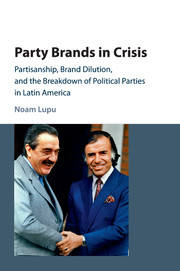 Party Brands in Crisis
Party Brands in Crisis Book contents
- Frontmatter
- Dedication
- Contents
- List of figures
- List of tables
- Acknowledgments
- 1 Why do parties break down?
- 2 Brand dilution and party breakdown
- 3 Explaining party breakdown across Latin America
- 4 Argentina: Peronism survives, Radicals collapse
- 5 Venezuela: AD and COPEI break down
- 6 Party brands and mass partisanship: experimental evidence
- 7 Party brands and mass partisanship in comparative perspective
- 8 Parties, partisanship, and democracy: conclusions
- Appendix
- Bibliography
- Index
7 - Party brands and mass partisanship in comparative perspective
Published online by Cambridge University Press: 18 December 2015
- Frontmatter
- Dedication
- Contents
- List of figures
- List of tables
- Acknowledgments
- 1 Why do parties break down?
- 2 Brand dilution and party breakdown
- 3 Explaining party breakdown across Latin America
- 4 Argentina: Peronism survives, Radicals collapse
- 5 Venezuela: AD and COPEI break down
- 6 Party brands and mass partisanship: experimental evidence
- 7 Party brands and mass partisanship in comparative perspective
- 8 Parties, partisanship, and democracy: conclusions
- Appendix
- Bibliography
- Index
Summary
In Latin America, party convergence is associated with weakening partisan attachments. And that relationship appears to be causal: when survey respondents were given information that signaled party convergence, they became less likely to say that they identify with a party. However, the recent dramatic policy switches and strange-bedfellow alliances in Latin America are rare in other parts of the world. Perhaps we are observing a contingent set of relationships that will not obtain elsewhere. In other settings, does party polarization clarify party brands and strengthen voter partisanship?
There are good reasons to think not: party polarization has long been seen as a problem for democracy. Studies link the polarization of the Democratic and Republican Parties in the United States to legislative gridlock, elite incivility, income inequality, and voter disengagement (e.g., Hetherington 2009; Layman et al. 2006; McCarty et al. 2006). Scholars also blame party polarization for democratic breakdowns in Germany's Weimar Republic, France's Fourth Republic, and Chile prior to 1973 (Sani and Sartori 1983; Sartori 1976; Valenzuela 1978; but see Bermeo 2003). And across a broad range of countries, polarization also seems to contribute to corruption, bad economic performance, and smaller government (Brown et al. 2011; Frye 2002; Lindqvist and Östling 2010).
But we still know little about the relationship between party polarization and individual attitudes like voter partisanship. Research in the United States highlights the coinciding rise in party polarization and resurgent voter partisanship (Abramowitz and Saunders 2008; Bartels 2000; Brewer 2005; Hetherington 2001; Levendusky 2009). But these studies primarily describe trends within a single case. They leave unexamined the causal connection between party polarization and individual partisanship. A handful of comparative studies find a similar association between party polarization and rates of partisanship in aggregate terms (Berglund et al. 2006; Holmberg 1994; Schmitt 2009; Schmitt and Holmberg 1995). But these studies rely on simple correlations from a very small sample of Western European countries. Do these correlations generalize beyond this limited sample? Do voters actually register party polarization and change their perceptions of their parties?
At the individual level, the causal link between party polarization and voter partisanship also remains both unclear and untested. Studies of the United States and Western Europe emphasize the salience of party competition. Following Carmines and Stimson (1989), they expect voter partisanship to increase as parties become more and more salient in political discourse.
- Type
- Chapter
- Information
- Party Brands in CrisisPartisanship, Brand Dilution, and the Breakdown of Political Parties in Latin America, pp. 152 - 171Publisher: Cambridge University PressPrint publication year: 2016
